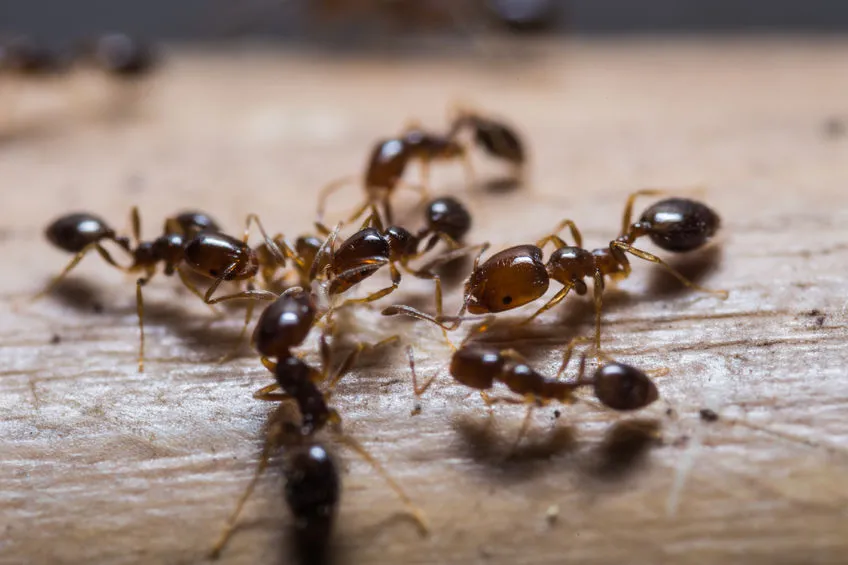If you have lived in Texas for any length of time, you have probably encountered fire ants. This invasive species of ants is very aggressive and problematic.
Fire ants prefer warm, moist climates and are native to South America. Around 1930, probably in soil shipments, they were introduced to the States by way of the port in Mobile Alabama. They quickly took hold and spread across the southern US and eventually made their way to Texas by the 1950s.
While there are some native varieties, the red imported fire ants are most prevalent. They are reddish brown in color and can range in size from 1/16th to 1/4th of an inch long. They do not have openings in the middle of there mounds like most ants. They travel in and out through underground tunnels. If the mound is disturbed, hundreds of ants will swarm to the top and attack.
Fire ants bite and sting victims.
These bites can cause pain and itching, along with blisters and welts. They are very aggressive and can bite multiple times. Sometimes a more severe reaction can occur in individuals who are allergic.
Besides being a pest, fire ants are a problematic invasive species. They have displaced native ants from their habitats. They have reduced numbers of some native Texas animals, such as the horned lizard. They are a hazard for ground nesting birds as well. They can even be harmful for young deer and cattle as they lay on the ground.
Fire ants can also cause damage and have a negative economic impact. In Texas alone, they cause about 1 billion dollars in damage every year. They like electrical currents and can short circuit lights and other electrical equipment. They destroy farmland and farm equipment, and can cause damage to golf courses.
RELATED TIP: What to Trim in February
When and Where do Fire Ants Show Up
Fire ants commonly nest along driveways and sidewalks in residential areas. They also can nest under slabs or along foundations. Sometimes they enter homes through gaps for utility lines or around doors and windows.
Mounds are most noticeable after rains when the ground becomes too wet. While these ants probably are in Texas for good, there are some ways to treat them.
When is the Best Time to Treat Fire Ants
The most common method for treating fire ants is called the “Texas two-step”, which is a two step method for removing them from lawns.
The first step is to use bait insecticide over the whole lawn or affected area, usually in late summer to early fall. Fire ant bait consists of processed corn grits coated in soybean oil. This bait is gathered by the worker ants and brought back to the colony. It is then fed to the queen who dies or becomes infertile.
Baits are slow acting and can require weeks to months to achieve 80-90% control. If treated while ants are still foraging in late August to mid October, they can then be working over the winter months.
For best results, use fresh bait from an unopened package. Use a hand spreader and don’t mix with seed or fertilizer. Apply when the ground is dry and rain is not expected in the next 24-48 hours. Apply in late afternoon or evening when workers are foraging for food. You can place a test pile close to the mound to see if workers have found it within 30 minutes.
RELATED TIP: How to Remove a Large Shrub
Step two is to treat the problematic remaining mounds. These can be treated chemically with drenches, dust, or granular treatments.
Dust treatments work quickly without water, but can leave a surface residue.
Liquid drenches can eliminate mounds in a few hours with little surface residue and may be the safest option with less chance of contact with pets or children. Pets and children should still be kept away from treated areas. It can be harmful to use around water sources, so read directions carefully or use a professional.
Granular treatments are put on and around the mound and then sprinkled with 1-2 gallons of water without disturbing the mound. They are also fast acting.
For an organic treatment method, there are some botanical insecticides and biological agents available. Boiling water can also be poured into the mound. Use 3 gallons of boiling water and pour directly into the mound. This is about 60% effective, though it might just make the mound move to another location. It can also kill any grass or vegetation around the mound.
Evergreen Lawn & Landscape takes all the guesswork out of treating your lawn in the greater Denton, TX area. We use Top Choice treatments, good for up to one year. Contact us for more info.



Comments (0)
Thanks for your comment!
Thanks for your feedback! Your comments have been successfully submitted! Please note, all comments require admin approval prior to display.
Error submitting comment!
There is a problem with your comment, please see below and try again.